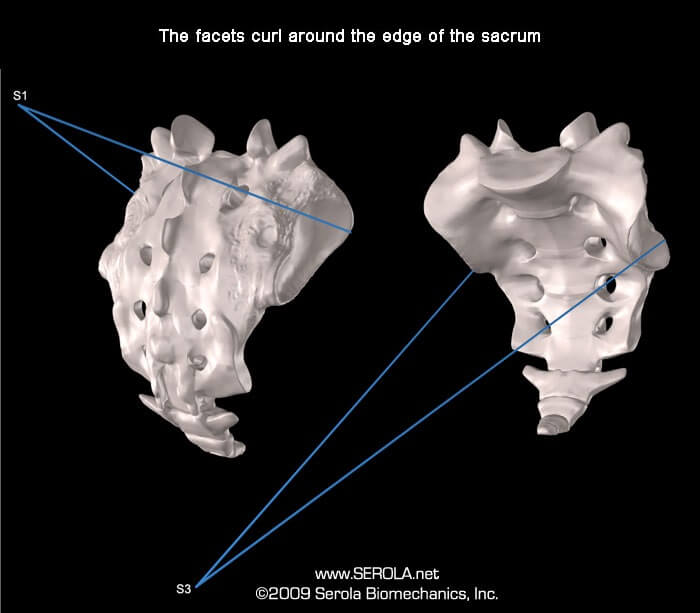Facets Curl Around the Sacrum

The superior portions of the sacral surface face posterolaterally and the inferior portions face anterolaterally [1-4]. Thus, the orientation of the upper and lower articular surfaces denotes a twisting motion. In effect, they curl around the lateral edges of the sacrum forming, in my view, a modified saddle joint. As a pivot point, the axial sacroiliac joint is at the center point where the joint twists from a posterior orientation to an anterior orientation.
The movement pattern of the sacroiliac joint is complicated due to the shape of the sacrum and the orientation of the articular surfaces. This 3D view Illustrates that the sacrum cannot slide linearly along a track composed of the ridge and groove [5], nor can the sacrum rotate around a transverse axis. Because the posterior facing surface is superior to the anterior facing surface, the sacrum must pivot on an oblique axis [6], centered at the axial joint.
By curling around the edges of the sacrum, the facets round out the edges of the sacrum, transforming the wedge shape into a cone shape at the articular regions. Since the joint surfaces determine range of motion, the anterior and posterior sacral surfaces may be relatively flat and the sacrum may still function as a cone. For a demonstration video, please see Sacrum Compared to a Cone
References:
- Solonen, K.A., The sacroiliac joint in the light of anatomical, roentgenological and clinical studies. Acta Orthopaedica Scandinavica. Supplementum, 1957. 27(Suppl 27): p. 1-127.
- Dijkstra, P.F., A. Vleeming, and R. Stoeckart. Complex Motion Tomography of the Sacroiliac Joint and an Anatomical and Roentgenological Study. in First Intedisciplinary World Congress on Low Back Pain and Its Relation to the Sacroiliac Joint. 1992. San Diego, CA.
- Snijders, C.J., Transfer of Lumbosacral Load to Iliac Bones and Legs: Part 1 – Biomechanics of Self-Bracing of the Sacroiliac Joints and its Significance for Treatment and Exercise. Clinical Biomechanics, 1993a. 8: p. 285-294.
- Vleeming, A., et al., The role of the sacroiliac joints in coupling between spine, pelvis, legs and arms., in Movement, Stability, and Low Back Pain, A. Vleeming, et al., Editors. 1997, Churchill Livingstone. p. 53-71.
- Weisl, H., The articular surfaces of the sacro-iliac joint and their relation to the movements of the sacrum. Acta Anatomica (Basel), 1954b. 22(1): p. 1-14.
- Mitchell, F.L., Jr. and P.K.G. Mitchell, The Muscle Energy Manual. Vol. 3. 1999, East Lansing: MET Press.

